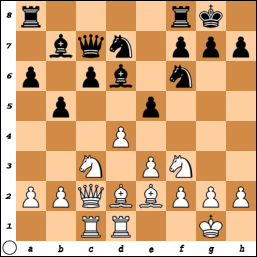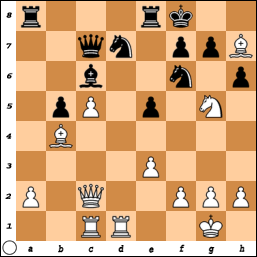Gelfand, who had already won the first game yesterday by countering an opening novelty of Karjakin with an astonishing piece sacrifice, struck again with White today in an even more convincing fashion:
1. d4 Nf6 2. c4 e6 3. Nf3 d5 4. Nc3 c6 5. e3 Nbd7 6. Qc2 Bd6 7. Bd3 O-O 8. O-O dxc4 9. Bxc4 b5 10. Be2 Bb7 11. Rd1 Qc7 12. Bd2 e5 13. Rac1 a6

Up until now play appeared to be standard. Black has achieved the freeing pawn thrust e6-e5 and White is now trying to take advantage of the central tension that has been created. While I was browsing through the game I thought the game would most likely develop into an endgame grind but then I saw Gelfand's next move...
14. b4!
I have not checked this with an engine but the move is certainly a very strong one if Black is not able to come up with a tactical solution pretty fast: White simply clamps down on the c5-square, exploiting the little tactic 14...Bxb4 15. Nxb5 followed by Bxb4, when White will still be clamping down on the key square.
14...Rfe8 15. Bd3 Bxb4?
After one preparing move, Karjakin is tempted into taking the pawn, as 16.Nxb5?? now allows 16...axb5 17.Bxb4 e4 which wins a piece for Black. Gelfand, however, has seen far ahead - very far indeed and I can only guess where Karjakin stopped calculating. I'd put my money on White's 21st move, which is a very nasty one and easy to miss, too (at least from my point of view).
16. Ng5! h6
16...Bxc3 17.Bxh7+ would leave Black in even deeper trouble.
17. Nxb5 axb5 18. Bh7+
The first point: After the forced reply, White can capture the bishop with check.
18...Kf8 19. Bxb4+ c5 20. dxc5 Bc6

It seems as if Black is in control again. He has blocked the pawn on c5 and threatens to take over the initiative, e.g. 21. Nh3 e4 22. Bf5 and now the Black king would be able to safely return to g8 while Black could start the siege of White's a-pawn. However, Gelfand has seen further than here...
21. Be4!!
White has just produced one of those moves that we're calling "A...lochzüge" in German, i.e. "a..hole moves" in English. It decides the game because it allows White to keep the initiative with Black not having had a chance to consolidate yet.
21...Nb8
Neither 21...Bxe4 22.c6+ nor 21...hxg5 22.Bxc6 Qxc6 23.Rd6 followed by a discovered check offer Black chances of survival.
22. Nh7+ Nxh7 23. Bxh7 g6 24. Rd6 Re7 25. h4 h5 26. Bxg6 fxg6 27. Qxg6 Rxa2 28. Rcd1 Rf7 29. Qh6+ Rg7 30. Qf6+ Kg8 31. Rd8+ Kh7 32. Qf5+ Rg6 33. Qxh5+ Rh6 34. Qf5+ 1-0
An absolutely beautiful game!


b4 is indeed a pretty nice move. According to Megabase 2009 it is a novelty and my engines did not throw any good tactics for black.
ReplyDeleteMaybe I should give this variation a try ;-)
A...zug :-)
ReplyDeleteHow is it called in finnish?
Well, I believe there's no word that carries this exact connotation.
ReplyDeleteEven in English chess players wouldn't understand "a...hole move" in the sense we're using it... they might if they'd just made a move like 21.Be4! and I'd say "whoaa, what an a...hole move".
In this sense:
persereikä = a...hole
siirto = move
So I would try "persereikäinen siirto" and check whether Finns would understand ((-;
Geez, this is profane...